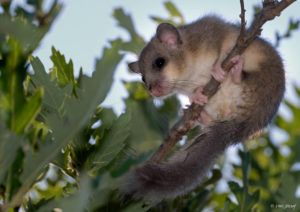Species and habitat description
The edible dormouse is the largest of all dormouse, being around 14 to 19 cm in head-body length, plus about 12 cm long tail. It weighs ca 150 g. Differentiation in body size between sexes is not apparent (monomorphic). It has a generally squirrel-like body, with small ears, short legs, and large feet. Its fur is grey or greyish-brown in colour over most of the body, while the underparts and the inner surface of legs are white to pale buff; the line of demarcation is rather well defined. Eats flower buds, insects, tree bark, beech mast, fruits (especially blackberries and elderberries), acorns and occasionally birds’ eggs.
It is typically found in mature deciduous and mixed woodland, where it frequents the canopy, although it also occurs in maquis and shrubland on rocky areas along the Mediterranean coast. Man-made habitats such as gardens and orchards are sometimes used, and the species often enters buildings.
Major threats
In parts of its range, including Slovenia, Croatia, and Italy, there is a tradition of hunting this species. In the past, it was a source of meat, fat, and skins for subsistence and trade, but today it is hunted recreationally. The species is protected in Italy and Hungary, but sometimes illegally hunted. Threats are the habitat fragmentation and eliminated dead woods and mixture species, too.
Specific conservation action
Increase the diversification of the age and size of the trees, make standing deadwood.

Related project areas
Tihany
Bibliography
Tartuffe-ek, B. (2010). “Glis glis (Rodentia: Gliridae)”. Mammalian Species. 42 (1): 195–206.
Kryštufek, B. 1999. Glis glis. In: A. J. Mitchell-Jones, G. Amori, W. Bogdanowicz, B. Kryštufek, P. J. H. Reijnders, F. Spitzenberger, M. Stubbe, J. B. M. Thissen, V. Vohralík and J. Zima (eds), The Atlas of European Mammals, pp. 294-295. Academic Press, London, UK.
Macdonald, D.W. and Barrett, P. 1993. Mammals of Britain and Europe. Collins, London, UK.